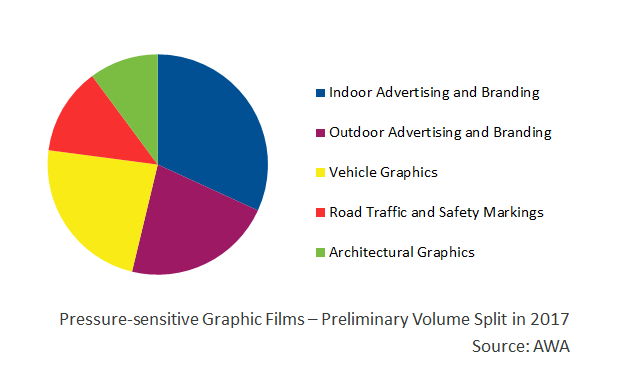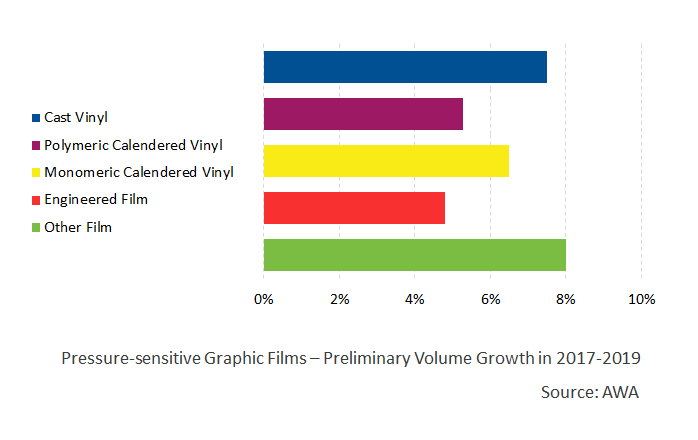Despite the best efforts of Hurricane Harvey, the AWA Pressure-sensitive Graphic Films Seminar took place as scheduled in New Orleans on October 9, bringing to the US signage, vehicle graphics, architectural graphics, and promotional graphics market, across the supply chain, an update on global market developments and technologies coupled with industry innovation and issues.
The 2017 edition of this annual event, which alternates between Europe and USA, opened with an overview of the global graphic films market from Sami Mulari, Manager, Market Research and Consulting, for AWA Alexander Associates – global market researchers and consultants with a unique industry focus on the specialty paper, film, packaging, printing, coating and converting sector.
Regional, segment and film specific market data
Mulari showed how the robust graphic films arena will grow at a solid annual growth of 6% to 2019 globally, with the greatest prospects volume growth prospects in Asia – with a compound annual growth rate (CAGR) of 8.3%. Indoor advertising and branding applications still claim the highest percentage market share globally, but the vehicle graphics sector will, he said, experience the greatest upswing to 2019 – 8.5%. Another durable outdoor application, architectural graphics, is also experiencing positive development, and is forecast to grow at 7% to 2019. Both these markets are home to cast, polymeric calendered vinyl and non-PVC films, depending on the desired life and application. The changing wide-format market
The changing wide-format market
Steve Urmano, Director of Wide Format for Keypoint Intelligence/InfoTrends, then took the stage to delve more deeply into the opportunities for pressure-sensitive materials for wide-format printing. This is a market where growth is unquestionably being driven by new and developing applications and technologies.
Urmano explored the reasons why some of today’s most vibrant large-format graphics markets are enabled by the emerging available imaging technology base, and by direct-to-product 3D print/additive manufacturing. These new applications include textiles, wallcoverings, and plastic on-the-go beverage containers.
Single-pass aqueous inkjet is the fastest-developing field, forecast to grow at 14% globally to 2021, as a result of the high production speeds and good image quality it offers, although image durability and substrate choice are both limited. Latex print for durable labels, signage, and textiles is enjoying a CAGR in North America of 10.3%, thanks to its ability to print on such a wide variety of media. Flatbed UV inkjet is proving the most versatile of today’s technologies, and is used on substrates as varied as metals, corrugated card, fabrics, wood, and membrane switches.
Thermoplastic polyurethanes
The properties of polyurethane films and the demanding applications they cover were then discussed by Steve Smith, Commercial Director, Surface Protection and Graphics for SWM International. He discussed the chemistry of aliphatic thermoplastic polyurethanes (TPU), which have been used for more than 20 years to protect automotive paint from scratches and chips. Their UV light-blocking benefits are also ideal for surface protection of print and adhesives. They offer UV stability; retain image quality and gloss, even after lengthy weathering; and are self-healing. TPU overlaminates should, he adjured, be specified for graphic applications where the highest brand image results are desired in terms of image gloss, color stability, and non-yellowing; for horizontal application of digital print media or overlaminating films; in geographical regions of high solar irradiation; on textured surfaces; and for applications where PVC is not desired for environmental reasons.
Successful retail graphics
Darren J Speizer, Vice President, Sales and Marketing, and Olga Bates, Brand Manager, from adhesive coating experts Drytac Corporation, looked at today’s options for quality pressure-sensitive retail graphics. In a highly-visual presentation of successful and eye-catching end results achieved with their print media, they showed how they can deliver smart technology, effortless installation, cost-effectiveness, and clean and predictable removability.
Making it simpler to make the choice
Anna Hurbanic, Owner and CEO of Promotive -- producers of selectors, colour cards, swatch books, and other materials for a wide range of signmaking materials – offered ways to simplify the decision-making process when it comes to selecting graphic films for different market players. Audience, application, and material are the core concerns; and different communication means and tools are required to provide a pathway to simplify and speed up the final choice. As well as costly options such as advertising placement, event participation, and a salesman’s time, she highlighted the key baseline physical activities – eg swatches, datasheets, and brochures – as well as today’s digital tools: websites, mobile apps (the fastest-growing choice); social media; and online videos/tutorials. For graphic films, she concluded, ‘real samples will always stay real samples... Customers need to see and touch them, but... Yes, going mobile is a must.’
Ink/substrate combinations
The ‘make or break’ significance of ink and substrate combinations were underlined by Cory Sawatzki, Director, Digital Print Technology, for colour management specialists CGS Publishing Technologies International. When choosing what inks and print system to employ for a particular project, it is important to check that the project’s special needs are taken into account. For any graphic, quality, speed, durability, color gamut, footprint, and substrate choice are all key factors, and Sawatzki provided invaluable in-depth guidelines on getting it right first time.
‘Fast track to the future’
Neil Baker, Americas Large Format Sign and Décor Category Manager for HP, looked at the company’s technologies which are delivering a ‘fast track to the future’ for the printing market. Partnering the global megatrends that are changing our lives, he showed, HP innovations are moving print from solvent and UV to water-based inks; making print machines ‘smart’; adding an endless variety of application substrates to basic papers; and moving scanning to single-pass print. With its extensive portfolio of eco-solvent , anti-scratch, and anti-edge-curl inks; with the HP PrintOS cloud-based print production operating system’s web and mobile apps to simplify production; and with latex print’s successful results in the growing field of textile decoration, HP is, said Baker, ‘revolutionizing the market’.
Indoor advertising and branding
The correct product for the correct application in the indoor advertising and branding arena was the subject addressed by Bruce Erbeck, South East Regional Manager for Catalina Graphic Films, custom coaters of pressure-sensitive materials for the digital, offset, screen, industrial and specialty markets. Product and related appropriate application procedures for pressure-sensitive graphics on windows, walls (including painted walls) and floors (UL-approved substrates) were discussed, along with the use of a mounting film to make a simple non-adhesive decal pressure-sensitive; and achieving the best results with different adhesives – permanent, removable, ultra-removable.
Closing remarks
Closing the seminar at the end of a full day’s agenda, Sami Mulari thanked the seminar’s gold sponsors HP and UPM for their support, and the participants for their debate – both with speakers and during seminar networking breaks.

